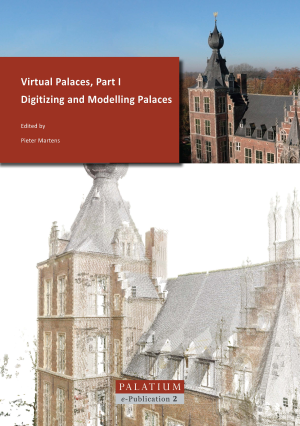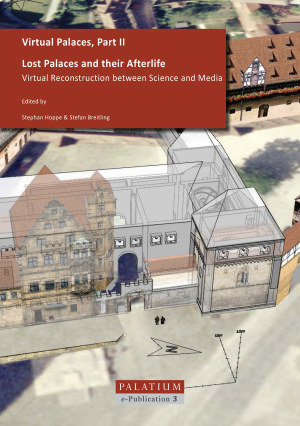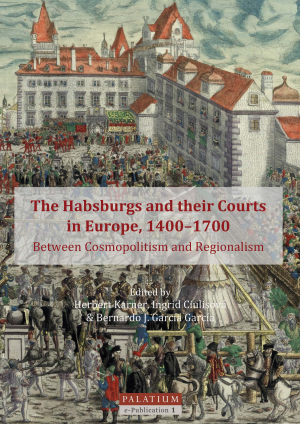De Jonge, Krista
Virtual Palaces, Part I: Digitizing and Modelling Palaces
Dieser Band befasst sich mit den Möglichkeiten virtueller Modelle für die wissenschaftliche Erforschung historischer Orte und Plätze. Das Aufkommen digitaler Messtechniken und Entwicklungen im Modellbau haben die Art und Weise revolutioniert, in der historische Gebäude wie bspw. Residenzen untersucht werden können. Die neuen Techniken bieten noch nie da gewesene Möglichkeiten für Architekturhistoriker, führen aber auch zu neuen Herausforderungen.
Eine dieser Herausforderungen betrifft die Zuverlässigkeit und Nachprüfbarkeit der Daten, die für die Erstellung der Modelle – sowohl bestehender als auch rekonstruierter Bauten - verwendet werden. Auch die Verwendung virtueller Gebäude als eigentliche „Werkzeuge“ für die Forschung, die dabei helfen sollen, Hypothesen über Bauphasen oder zur zeremoniellen Verwendung von Räumen zu visualisieren und zu erläutern, birgt nicht selten Probleme.
The Interior as an Embodiment of Power: The Image of the Princely Patron and its Spatial Setting (1400-1700)
This volume is dedicated to the study of the in- and outside of princely residences and of their setup as the stage for a developing European early modern court culture. At a time of increasing aristocratization (1400-1700) and with many new nascent princely courts, both the princely person and the performance of princely power required an appropriate type of elaborate backdrop as its setting. Even though such an interest in the palace interior and its functions is not entirely new, interior architecture and court culture have only recently come to be seen as two sides of the same medal: embodiment and expression of the princely presence.
Therefore, the essays included focus in particular on diverse types of functions that palaces and apartments, state rooms and privy chambers had to fulfil at certain periods and in certain residential contexts between the ages of feudalism and absolutism at courts in London, Edinburgh, Neuburg am Inn, Karlstein and Prague, Červený Kameň and Ludwigsburg. They compare and contrast specific local examples with international trends such as, for example, the palace and court ceremonial developed at or adapted to diverse circumstances in Burgundy, Spain or Lithuania. Consequently, the aim of this volume consists of the combination of personal and dynastic ambitions with fashionable trends and court etiquette followed by royalty and minor princes alike during a period of calculated magnificence. It considers processional routes towards the presence of the ruler or towards its image. Thereby, it helps to define the complementary roles of residential interiors and of the courtly personnel at the same time.
The ten papers collected in this volume were first presented at the PALATIUM colloquium The Interior as an Embodiment of Power―The Image of the Prince and its Spatial Setting (1400–1700), organized by Stephan Hoppe, Krista De Jonge and Stefan Breitling and held in Bamberg in October 2013.
Virtual Palaces, Part II: Lost Palaces and their Afterlife. Virtual Reconstruction between Science and Media
Der Band befasst sich mit der digitalen Rekonstruktion und Visualisierung von Schlössern, Burgen und Residenzarchitektur der Frühen Neuzeit. Das Hauptaugenmerk liegt dabei weniger darauf, digitale Modelle von noch bestehenden Gebäuden zu erstellen als vielmehr auf der virtuellen Rekonstruktion „verlorener“ Bauten, besonders bezogen auf Schlösser, die zerstört, stark umgebaut oder auch nie errichtet wurden.
Die 13 Aufsätze des Bandes wurden zuerst anlässlich des Palatium Workshops "Virtual Palaces, Part II" präsentiert, der im April 2012 in München stattfand.
Looking for Leisure: Court Residences and their Satellites 1400–1700
This volume focuses on the leisure buildings – often called casino, palazotto or Lusthaus – which formed an integral part of princely residential complexes in Europe in the period 1400–1700. The aim of this collection is to study these satellite buildings as counterparts to the main palaces. The relatively small size of these structures belies their importance. They took on representative roles and developed certain ideological programmes that would have been difficult to achieve in the larger residential buildings.
Many of these buildings were meant only for seasonal use. Their primary role was as a place of rest, leisure and repose. This relaxation could either take a contemplative form or could include such vigorous activities as hunting, sports and various court festivities. The case studies presented here illustrate the shared principles of these recreational buildings and investigate how their architects and patrons attempted to realize a ‘paradise on earth’ and managed to bring the human world into harmony with the natural world.
Discussing examples from all over Europe – from Central Europe via Italy and France to Denmark and Scotland – the seventeen papers gathered in this volume address four different aspects of ‘palazotto culture’: the terminology that was used to identify these small palaces, which reflects the wide variety of needs they fulfilled; the functions and typologies of these buildings; their artistic decorations; and their gardens and natural surroundings.
The Habsburgs and their Courts in Europe, 1400–1700: Between Cosmopolitism and Regionalism
Dieser Band untersucht Architektur und Kultur an verschiedenen Höfen einer der wichtigsten Königsdynastien Europas, der Habsburger. Er sucht nach der spezifisch Habsburgischen Ausdrucksweise im Bereich fürstlicher Repräsentation an den Höfen von Madrid, Brüssel, Wien, Prag, Bratislava und Budapest. Überstaatliche Charakteristika der dynastischen Identität werden den regionalen Repräsentationen gegenübergestellt.
Kern der fürstlichen Repräsentation war die Hofresidenz. Infolgedessen werden die offiziellen Räume der Habsburger bezogen auf ihre Bedeutung im Hofzeremoniell in den Schlössern in Brüssel, Madrid und Zentraleuropa untersucht, um zu erkennen, ob es ein vereinendes Modell gab. Diese von den Habsburgern entwickelte, übernationale dynastiche Identität wird dann mit lokalen Identifikationsformen verglichen, wie sie beim Adel in Böhmen, Ungarn und Polen anzutreffen sind. Dies zeigt wie die Schlösser und ihre Ausschmückung auch die Loyalität zu den Traditionen des Heimatlandes, den sogenannten Landespatriotismus, ausdrückten.











